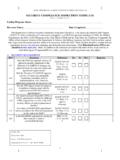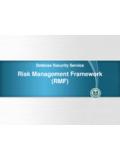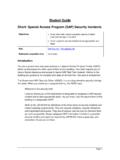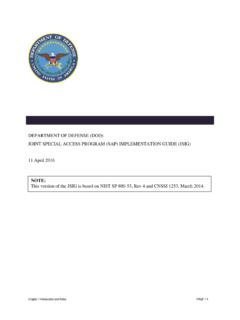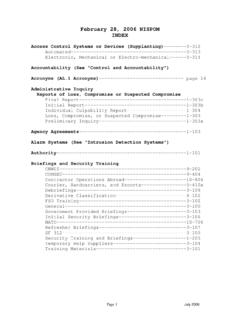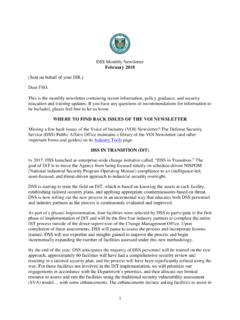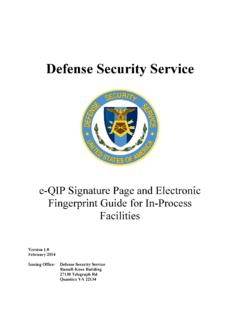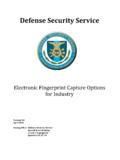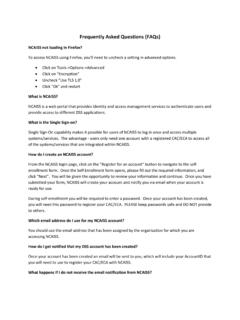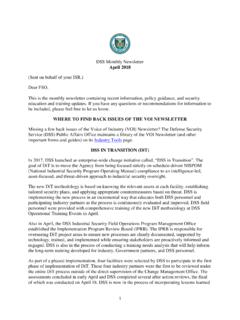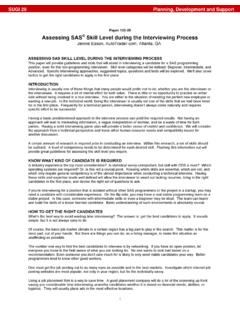Transcription of DSS Monthly Newsletter
1 1 DSS Monthly Newsletter May 2018 (Sent on behalf of your ISR.) Dear FSO, This is the Monthly Newsletter containing recent information, policy guidance, and security education and training updates. If you have any questions or recommendations for information to be included, please feel free to let us know. WHERE TO FIND BACK ISSUES OF THE VOI Newsletter Missing a few back issues of the Voice of Industry (VOI) Newsletter ? The Defense Security Service (DSS) Public Affairs Office maintains a library of the VOI Newsletter (and other important forms and guides) on its Industry Tools page.
2 DSS IN TRANSITION (DiT) In 2017, DSS launched an enterprise-wide change initiative called, DSS in Transition . The goal of DiT is to move the Agency from being focused strictly on schedule-driven NISPOM (National Industrial Security Program Operating Manual) compliance to an intelligence-led, asset-focused, and threat-driven approach to industrial security oversight. The new DiT methodology is based on knowing the relevant assets at each facility, establishing tailored security plans, and applying appropriate countermeasures based on threat.
3 DSS is implementing the new process in an incremental way that educates both DSS personnel and participating industry partners as the process is continuously evaluated and improved. DSS field personnel were provided with comprehensive training of the new DiT methodology at DSS Operational Training Events in April. Also in April, the DSS Industrial Security field Operations Program Management Office established the Implementation Program Review Board (IPRB). The IPRB is responsible for overseeing DiT project areas to ensure new processes are clearly documented, supported by technology, trained, and implemented while ensuring stakeholders are proactively informed and engaged.
4 DSS is also in the process of conducting a training needs analysis that will help inform the long-term training developed for industry, Government partners, and DSS personnel. As part of a phased implementation, four facilities were selected by DSS to participate in the first phase of implementation of DiT. These four industry partners were the first to be reviewed under the entire DiT process outside of the direct supervision of the Change Management Office. The assessments concluded in early April and DSS completed several after action reviews, the final of which was conducted on April 18.
5 DSS is now in the process of incorporating lessons learned 2 from the first phase into future phases and will continue to use expertise and insights gained to improve the process throughout the year. In April, DSS field Offices validated the list of cleared facilities associated with the Department s top priority technology and determined eight facilities to be reviewed during the second phase of implementation. These facilities have been contacted and pre-review activities are currently underway. DSS anticipates the reviews and post-review activities to be completed in the June/July timeframe.
6 Upon completion, DSS will once again stop to evaluate the process, incorporate lessons learned, and make further changes as appropriate. By the end of the year, DSS anticipates a majority of personnel will be trained on the new approach, facilities assessed will have developed a tailored security plan, and the process will be refined along the way. DSS will continue to assess and rate facilities not involved in DiT implementation in 2018 under the traditional security vulnerability assessment model. During these assessments, DSS will introduce facility security personnel to the concepts of asset identification and documenting business processes for the protection of assets.
7 DSS will also introduce facility security officials to a new threat assessment tool known as the 12x13 matrix. For more information on the DiT methodology, click here. SECURITY OVERSIGHT AND REVIEW ACTIVITIES In early 2018, DSS leadership briefed Government and Industry Stakeholder groups at a number of meetings, conferences, and seminars on the security review types that would be used by DSS field personnel during the year. Review types include a comprehensive security review, targeted security review, and enhanced security vulnerability assessment (SVA).
8 The comprehensive security review will follow the new DiT methodology. It is an unrated review that results in the development of a tailored security program. The targeted security review follows the new DiT methodology but stops short of developing a tailored security program. Targeted security reviews are rated under our traditional rating model. The enhanced SVA introduces facility personnel to the concept of asset identification, the concept of mapping business processes associated with protecting assets, and the the new threat tool known as the 12x13 matrix.
9 Enhanced SVAs follow the traditional SVA format and are rated. While not all facilities will receive one of these three reviews, the review type that a facility will receive will depend on a number of factors and internal DSS prioritization. DSS personnel will conduct meaningful engagements with those facilities not receiving one of the three review types. Meaningful engagements are activities designed to get a sense of the security posture at a cleared facility. DSS field offices have multiple activities they can leverage to conduct a meaningful engagement with a facility and these determinations will be made at the field office level based on resources and priorities.
10 While each of these activities will adhere to DSS authorities and NISP oversight, industry is encouraged to work directly with local field office representatives on any questions or concerns they have. 3 REQUESTS FOR INFORMATION From time to time, industry may receive correspondence from their local field office regarding their security program, classified contracts, or other NISP activities. These routine inquiries enable DSS personnel to validate a facility s continued participation in the NISP and helps to ensure DSS records are updated with pertinent, relevant, and current contract information.
